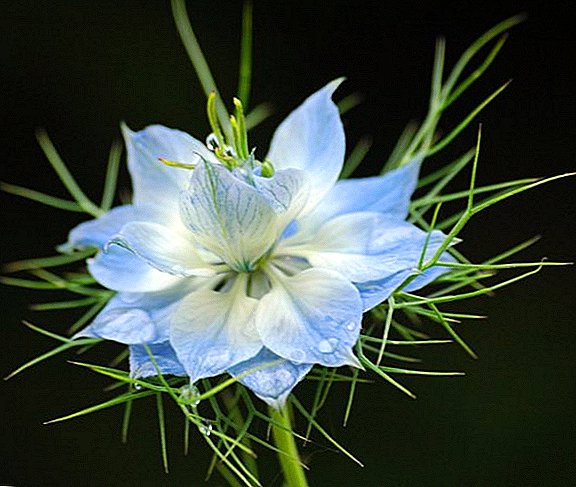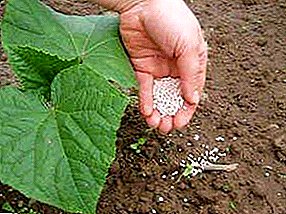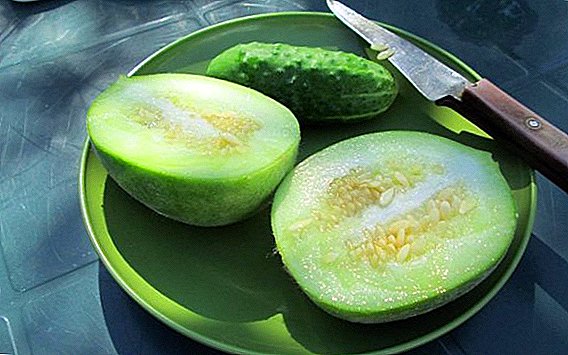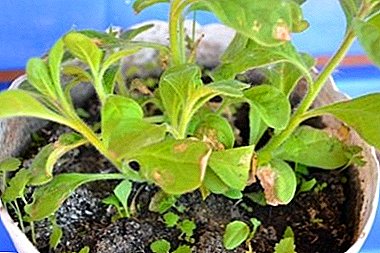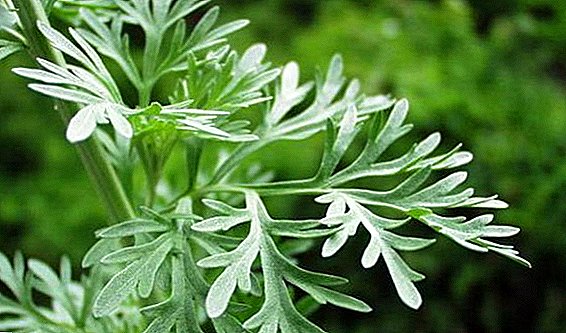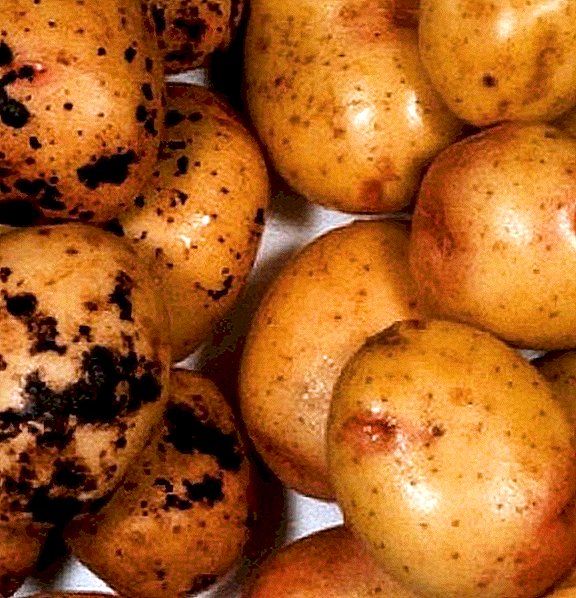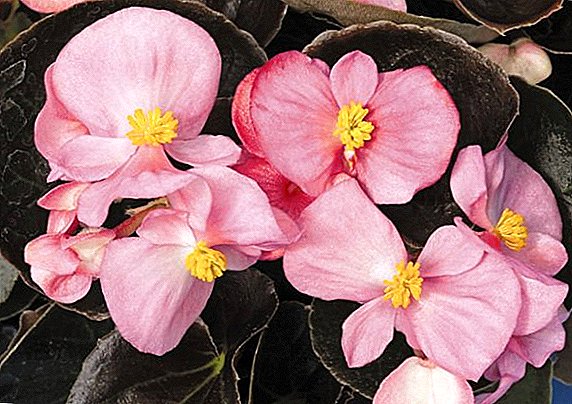 Among gardeners and indoor plants lovers, begonia evergreen or ever flowering deserves special attention.
Among gardeners and indoor plants lovers, begonia evergreen or ever flowering deserves special attention.
Its flowering continues for a long time and creates the impression of continuous.
Botanical description of indoor plants
The ever flowering begonia (semperflorens) belongs to the Begonia family. Perennial with a thick stem reaches 15-40 cm in height. It has smooth green leaves. Flowers monophonic, white, red or pink color. There are also two-colored, in which there is a pink frame on the white petals.
Male flowers have four petals, female - five. Ovary when ripe forms a box. Seeds are small.
Varieties of begonias ever flowering
The plant enjoys incredible popularity because it has a huge number of varieties.
Tall
The tall varieties are the semperflorens, reaching 30-40 cm. The most popular among them are:
- Alba It has a sprawling bush with medium abundant flowering. It has rich green glossy leaves and white flowers.
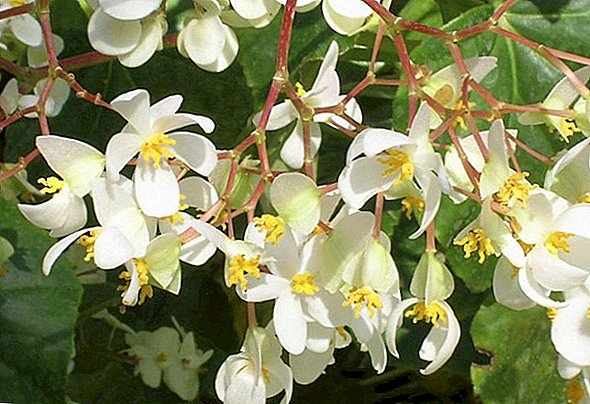
- Gustav Knaake. It is characterized by a sprawling bush, green leaves with a red border. Flowers bright coral color reach 3.5 cm in diameter.
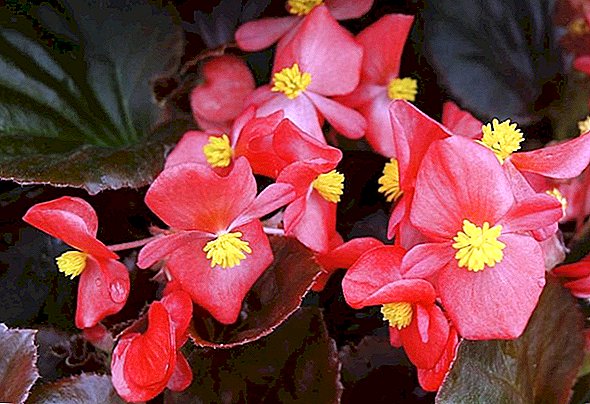
- Kate Teicher - Spreading bush reaching 30 cm. Green leaves with a red frame. Flowers are bright red.
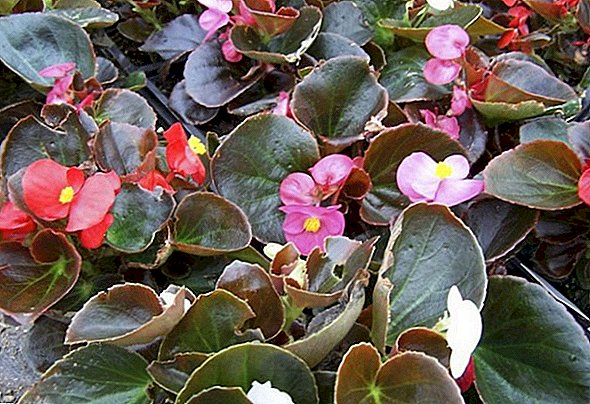
- Volumyya. The leaves have a bright green color, flowers - white, light pink and pink. Resistant to heat and drought.
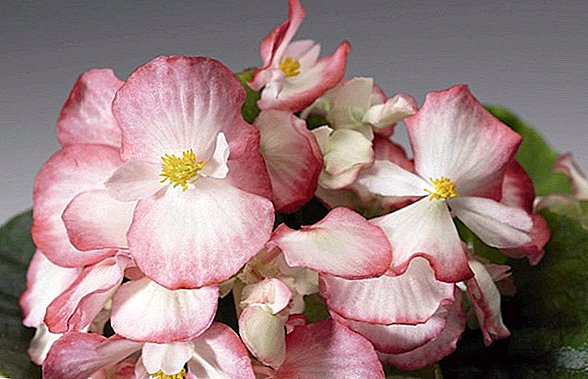
- Lotto. Characterized by emerald colored leaves and the presence of large flowers in different color combinations.
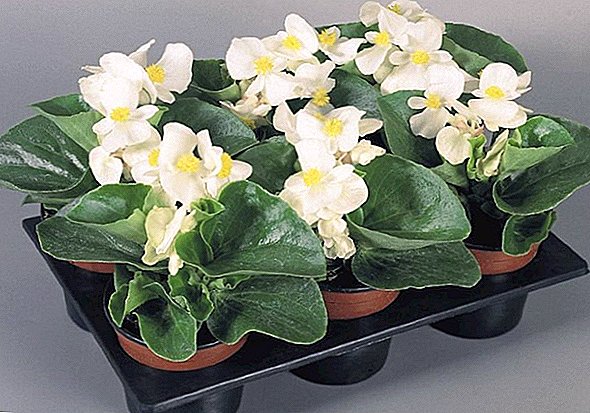
Medium thick
Medium grade includes varieties reaching 15-30 cm:
- Othello Compact shrub up to 24 cm. The leaves are dark emerald green, flowers - scarlet. Has abundant flowering.
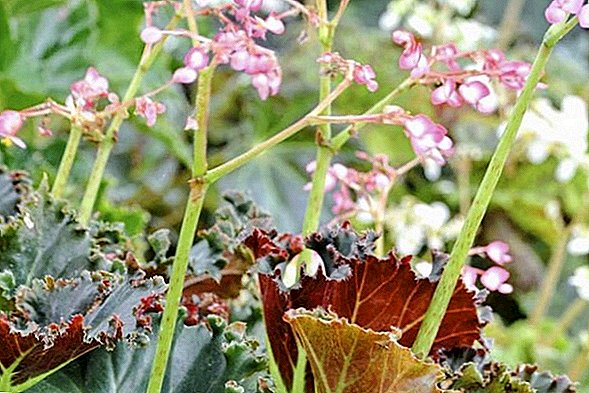
- The Ambassador. Color foliage green with red or white border. Flowers are red, pink or two-color.
- Bada boom Leaf color is bronze. Flowers are white, pink or bright red. Differs in early flowering.
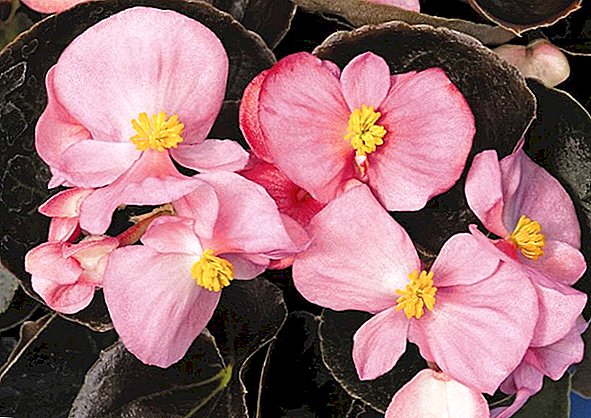
- Carmen It has brown leaves and pink flowers. It is characterized by abundant flowering.
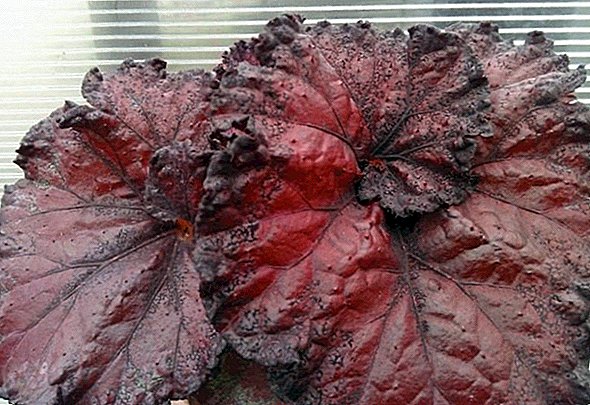
- Senator. Bronze foliage color, beautifully contrasted with rich red flowers.
Undersized (dwarf)
It is low-growing varieties are most often used for indoor breeding. The height of the bushes does not exceed 16 cm. Most popular:
- Ball Ed. Leaf color is green with red edging. The flowers are small, pearly red. Abundant bloom is characteristic.
- Bicola Green leaves. Small flowers in white color. Characterized by the presence of 4 flowers in the inflorescence.
- Eureka. The color of the leaves is dark green, flowers - white. The main feature is the large size of flowers that can be up to 4 cm in diameter.
- Fairy C The color of leaves is green with a red border. The flowers are red. Durable, consisting of 9 flowers inflorescence.
- Rosa Nova. Dwarf shrub up to 10 cm. Has green leaves and pink flowers. Abundant flowering is characteristic, up to 120 flowers on the bush.
Did you know? Today, more than 600 varieties of ever flowering begonias are known.
Optimum conditions for growing at home
Evergreen begonia does not apply to capricious indoor plants. But in order to achieve the most abundant flowering, you should choose the optimal conditions. 
Location and lighting
Semperflorens prefers a dim light, so it should be located on the western or eastern windows. If you want to achieve year-round flowering, it is necessary to provide this plant a 16-hour light day. To do this, use additional artificial lighting. When placed on the south side, create a diffused light using special screens or curtains.
Temperature conditions
The optimal temperature regime for evergreen begonia is + 20 ... + 24 ° С. At this temperature, begonia ever flowering retains flowering. If you want to create a rest period for semperflorens, then the temperature should be lowered to + 12 ... + 14 ° С.
Important! At temperatures below + 12 ° C, the begonia ever-flowering perishes.
Air humidity
Since the begonia ever flowering is a tropical flower, it needs high humidity. Direct spraying does not recognize, from him the leaves begin to darken. Spray should be around the pot. The best option is to place the plant in a pot on a tray with pebbles and add it to the water directly in the tray. 
Home care
Care in the summer and winter has its own characteristics.
Top dressing
As a top dressing, you can use ready-made products or you can prepare the nutritional mixture yourself.
Home remedies are:
- yeast solution;
- sugar solution;
- tea leaves;
- citrus peel;
- eggshell;
- banana peel;
- wood ash.
Important! Over-saturation with organic or mineral fertilizers can lead to the death of a flower.When making a feed should avoid falling on the foliage, because chemical burns can occur. In the summer, fertilizer should be applied in the evening, after having watered. In winter, if you want to achieve abundant flowering, you need to make phosphate flour. If you plan to immerse the plant in a state of rest, then you should reduce the frequency of fertilizer.

Watering features
Watering Begonias ever flowering is made of soft settled water. It is allowed to water by immersing the pot in water.
In the summer, you should water the plant every other day. In the winter - as the soil dries, but at least 1 time per week. 
How to properly trim and transplant
For the formation of a lush bush and improve flowering pruning of semperflorens is made. The first pruning is done on a young plant that has reached 6 cm. By cutting off the top, you stimulate the development of lateral shoots. Re-pruning is done with a length of shoots of 10 cm. After that, the bush is considered formed. Subsequent trimming is done at its discretion to maintain the correct shape. In addition, you should regularly cut off damaged and dry leaves. In winter, Everlasting Begonia does not need pruning.
Get acquainted with the features of the care of ornamental deciduous begonia at home.
Since the begonia is actively increasing the root system, it needs regular transplantation. Transplant produced in early spring. To do this, the plant should be removed from the pot, remove excess soil from the roots, remove dry or damaged roots. After that, the flower root is immersed for a few minutes in a weak solution of potassium permanganate. After washed under running water and allowed to dry. Next, the plant is planted in a larger pot. After transplantation, begonia needs more frequent watering.
Period of rest and flowering
Evergreen begonia does not need rest periods, it can delight with its flowering all year round. But to achieve abundant flowering and prevent premature aging of the plant, it is desirable to create a rest period in the autumn-winter time.  Begonia ever flowering loves plenty of light and moisture. Creating optimal conditions during the heating season is quite difficult, and, as a rule, during this period the plant does not look so attractive. In the dormant period, semperflorens gain strength and afterwards pleases with abundant blooms.
Begonia ever flowering loves plenty of light and moisture. Creating optimal conditions during the heating season is quite difficult, and, as a rule, during this period the plant does not look so attractive. In the dormant period, semperflorens gain strength and afterwards pleases with abundant blooms.
In order to introduce the ever-flowering begonia to the state of rest in the autumn, you should gradually reduce the number of waterings and the time of daylight. Next, trim the plant and place it in a dark, cool place until February. The period of main flowering at semperflorens begins from the end of February.
Breeding methods
There are several ways of breeding everglowing begonias.
Cuttings
For this method, shoots 10 cm long are used, on which there are 2-3 pairs of leaves. Cuttings is better to cut in spring and summer. The cut should be treated with activated carbon, remove the lower leaves. After that, the stalk can be planted immediately in the soil or put into the water for rooting. In order for this process to go faster, you can add a means to the water to stimulate the growth of the root system, which is formed within a month. 
Sowing seeds
This method is more complicated. It is mainly used in production. But if you wish, you can grow begonia from seed and at home. Sowing takes place from December to March. For planting, a soil is needed, which consists of peat and sand. The prepared soil is watered with warm water, they make indentations in which seeds are placed. Top seeds sprinkled with a thin layer of soil. After that, the pot is placed in a warm, bright place. The first shoots will appear in two weeks. When they reach 5 cm, you should dive.
Did you know? In 1 g of begonia seeds ever flowering there are 85 thousand units.
Pests and diseases
Like any houseplant, evergreen begonia can be attacked by pests or diseases.
Diseases:
- Mealy dew. Characterized by the formation on all parts of the plant round spots with white scurf. In the future, the affected areas darken, and the plant dies. To combat, you can spray a flower with a solution of 0.1% "Fundazol", a solution of 0.05% "Morestan", a 0.5% solution of colloidal sulfur.
- Gray rot, which is the causative agent of the fungus botrytis. Gray spots, gradually acquiring the appearance of gray rot, can appear on any part of the plant. The cause of the disease is excessive watering and high fever. To combat using a solution of copper sulphate and tar soap.
- Ring spots. The causative agent is a tomato virus. Characterized by the appearance of yellow-green lines. There is no effective treatment. The plant should be destroyed to prevent infecting others.
- Bacterial spotting. On the back of the sheet appear vitreous spots that can spread to cuttings and flowers. Infected plants are treated with a 0.5% solution of copper oxychloride. In case of severe damage, the plant should be destroyed.
 In addition to disease, semperfluence is subject to pest attacks:
In addition to disease, semperfluence is subject to pest attacks:
- Aphid greenhouse. Focuses on the back of the sheet. Defeat it leads to yellowing of leaves, fall of buds, wilt flowers. From improvised means used to combat tobacco infusion.
- Mug is soft. It affects the stalks, stems, leaves of the plant. Infected flower is rapidly deformed and dies. The struggle is carried out mechanically, for this, the whole plant is rubbed with a brush moistened in garlic solution.
- Red spider mite. A thin web appears on the affected plants. If you do not take action immediately, then holes appear on the leaves, the leaves turn yellow and soon fall off. For the fight should use purchased pesticides.
Find out why the room begonia leaves dry around the edges.
It is not always the fact that the plant does not bloom or leaves fall off, indicating a disease or damage by pests. Such symptoms may indicate improper care, so before starting treatment, you should carefully inspect the plant for damage or injury.
The ever flowering begonia is a bright representative of the tropics that settled on the windowsill. She is surprised by the abundance of varieties and their diversity. This is a flower with a character that, if properly cared for, will delight with its flowering all year round.










